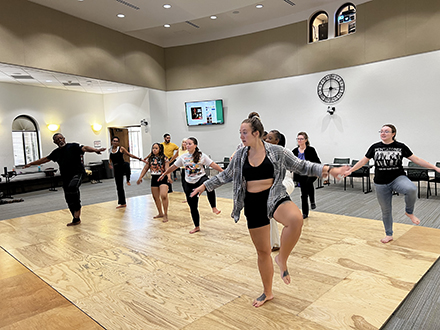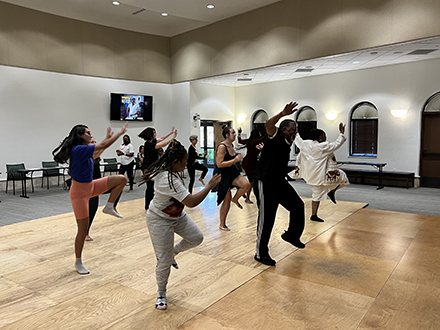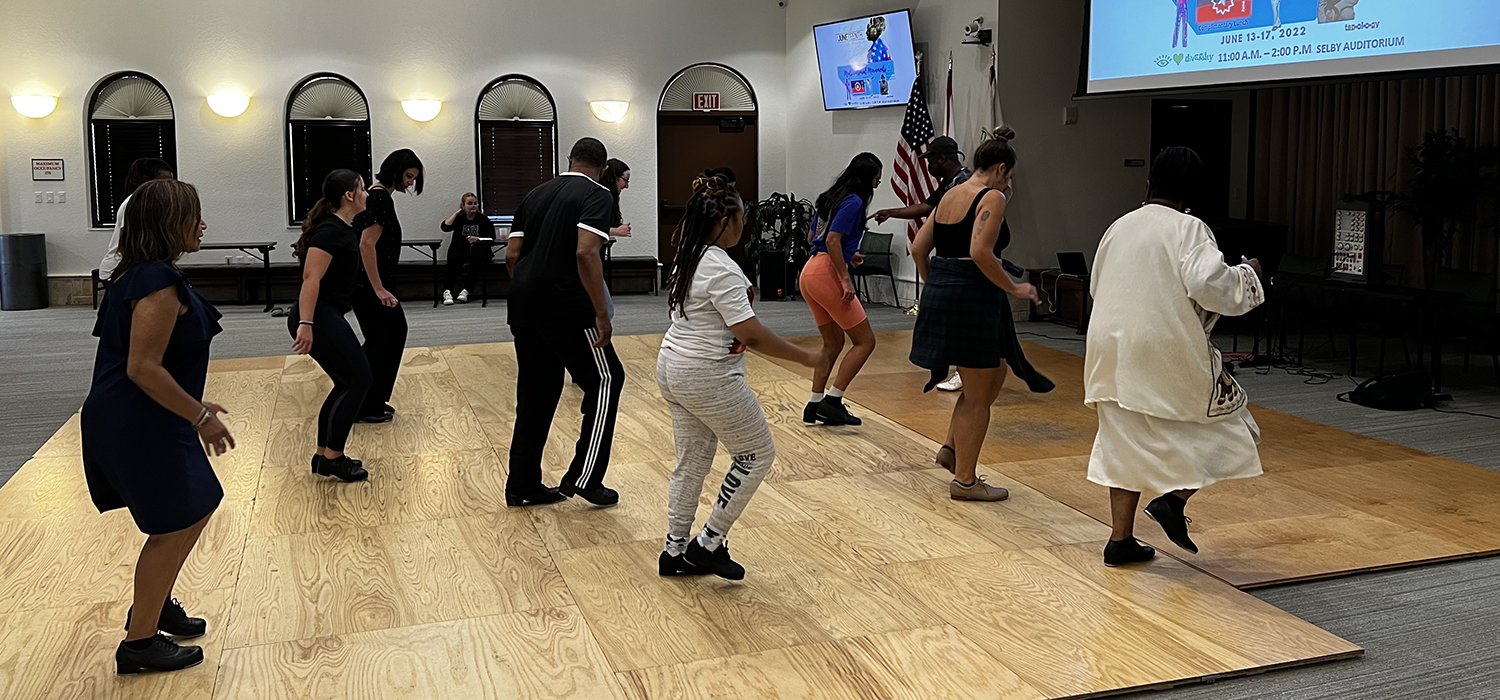Someone visiting Selby Auditorium on the University of South Florida Sarasota-Manatee campus during the pre-Juneteenth Lunch and Learn Series, could hear the “sounds of feet talking” through the derivatives from African culture, “Minjani,” “Djembe,” and the Ring Circle,” dances used to teach about Juneteenth, the holiday that commemorates the end of chattel slavery in the United States.
Over five days of multicultural arts-integrated instruction leading up to Juneteenth on June 19, about 30 USF faculty, students and staff shed their shoes for informative lessons on African, percussive and tap dance, following the beats of polyrhythms and prompts from teaching artists Maurice Chestnut, a Tony-Award winning dancer; Quynn Johnson, a world renown percussive dance artist; and Alfred Bruce Bradley, CEO of Tapology.

USF Sarasota-Manatee campus faculty, students and staff dance during the Juneteenth commemoration in in the Selby Center on June 14, 2022.
The Juneteenth Experience was a collaboration of the USF Center for PAInT (Denise Davis-Cotton, director; and Frances Bradley Vilier, learning and development facilitator) and the Office of Multicultural Affairs (Darren Gambrell, assistant director of student services).
The lessons of enslavement and emancipation were highlighted to show the importance of the Juneteenth holiday. Attendees learned that because drums were banned, enslaved Africans used the rhythms and sounds from body movements to imitate percussion instruments and to communicate secretly with each other to gain their freedom. And later, these sounds were key to the development of Black churches and other parts of American culture.
“Dance is bringing us closer to history,” said student Dahlia Martinez, who attended the session on Monday. “We are able to feel history through dancing.”
Another student, Samantha Campi, confessed she knew little about Juneteenth before looking it up on the internet before Monday’s lessons. She said she appreciated the chance to learn about the roots of the music and dance she enjoys.
“It feels good to give credit to where credit is due,” she said.
In addition to the dance lessons, attendees watched film clips on the styles of Bojangles, John Bubbles, Savion Glover, The Nicholas Brothers and Gregory Hines.
“The arts connect people to experiences, to knowledge, to life. The arts are engaging. The arts bring about meaning,” Davis-Cotton said. “What better way to interact and connect than dance and music and the visual arts?”
As of 2021, Juneteenth is the official federal holiday that commemorates the emancipation of enslaved Black Americans. The holiday traces back to June 19, 1865, when a Union general in Galveston, Texas, declared that slaves in Texas, the last state to have institutional slavery, were free. The announcement came more than two years after President Abraham Lincoln had issued the Emancipation Proclamation on Jan. 1, 1863.
“Juneteenth is significant in that the slaves in Galveston, Texas, had not heard they were actually free,” said Johnson, an award-winning artist, choreographer and author.
Black Americans have been celebrating the holiday for generations, since the first commemorations in Galveston in 1886, but to think of Juneteenth as only a Black holiday misses its importance for all Americans, Davis-Cotton said.

USF Sarasota-Manatee campus faculty, students and staff dance during the Juneteenth celebration in in the Selby Center on June 13, 2022. Visiting instructors led attendees in demonstrations of African, percussive and tap dancing.
Juneteenth, she said, is a day for all Americans to celebrate their shared freedom, and the many struggles to achieve it, and to recognize, ”if one group is not free, we are not all free.
“We should celebrate the achievements and the contributions of African ancestors in paving the way to freedom,” Davis-Cotton said. “We all as Americans can come to that understanding.”
That was echoed by Bradley, one of the instructors this week.
“When we study Juneteenth, we are celebrating democracy … We are celebrating a people who once were oppressed but now participate,” in the American way of life.
The Juneteenth series, entitled PAInTing Multicultural Movements, concluded Friday.
Also on Friday, USF faculty, staff, students and alumni participated in the Office of Multicultural Affairs Juneteenth Celebration on the USF St. Petersburg campus or virtually. View additional USF and community events here.
